AMD Radeon RX 6800 XT Roundup: ASRock, Asus, and Sapphire Reviewed
Factory overclocked RX 6800 XT cards that you still can't find in stock
We’ll shift away from the specific cards for the next several pages and look at gaming performance and other test results. We've tested all of the RX 6800 XT GPUs using AMD's most recent 20.12.1 drivers, and we'll include a few other GPUs as reference points in the charts. Our standard test bed hardware is listed to the right, and it includes a stock clocked (4.7 GHz all-core) Core i9-9900K processor with overclocked DDR4-3600 CL16 memory.
While our CPU reviews focus on performance with the CPUs at full stock, meaning DDR4-2666 memory on the 9900K, my take is that enthusiasts will at least enable the memory XMP profile, and DDR4-3600 kits are readily available. We looked at performance scaling with similar memory kits (all running at DDR4-3600) with Core i9-10900K and Ryzen 9 5900X, and while there are instances where the newer CPUs do better — particularly at 1080p — in general the top three current CPUs are all within spitting distance of each other.
Our testing for the RX 6800 XT cards will use our expanded test suite from recent reviews, which includes the same nine games that we've used for the past year, plus four newer releases. We've tested all of the games at 'ultra' settings (or whatever the highest preset is called — or in the case of Red Dead Redemption 2, we set all of the advanced settings to the minimum option and then set the basic settings to maximum).
Only two of the games we've tested have ray tracing enabled, and one of those (Dirt 5) is an AMD-promoted game using a still-in-beta DXR patch. We didn’t enable DLSS on any of the games, though it can boost performance quite a bit, especially at 4K. We also want to note that our testing suite is decidedly slanted toward AMD right now, with half of the games as AMD-promoted titles, and two of the newer additions (Assassin's Creed Valhalla and Dirt 5) relatively strongly favoring AMD. If you want to view the larger picture of how the various GPUs stack up, we recommend looking at the full set of results, including DXR testing that we've done in other articles, including the RX 6800 XT and 6800 launch review. Since we're mostly focused on the custom 6800 XT cards here, any inherent bias in our game selection is less of a factor.
We'll start with 1080p results and then move up to 1440p and 4K on the following pages, and wrap up with power and thermal testing. We have both stock and overclocked results for the four RX 6800 XT cards in the charts as well, which generally clump together. We'll focus our commentary on the main results, with the individual gaming charts as background detail.
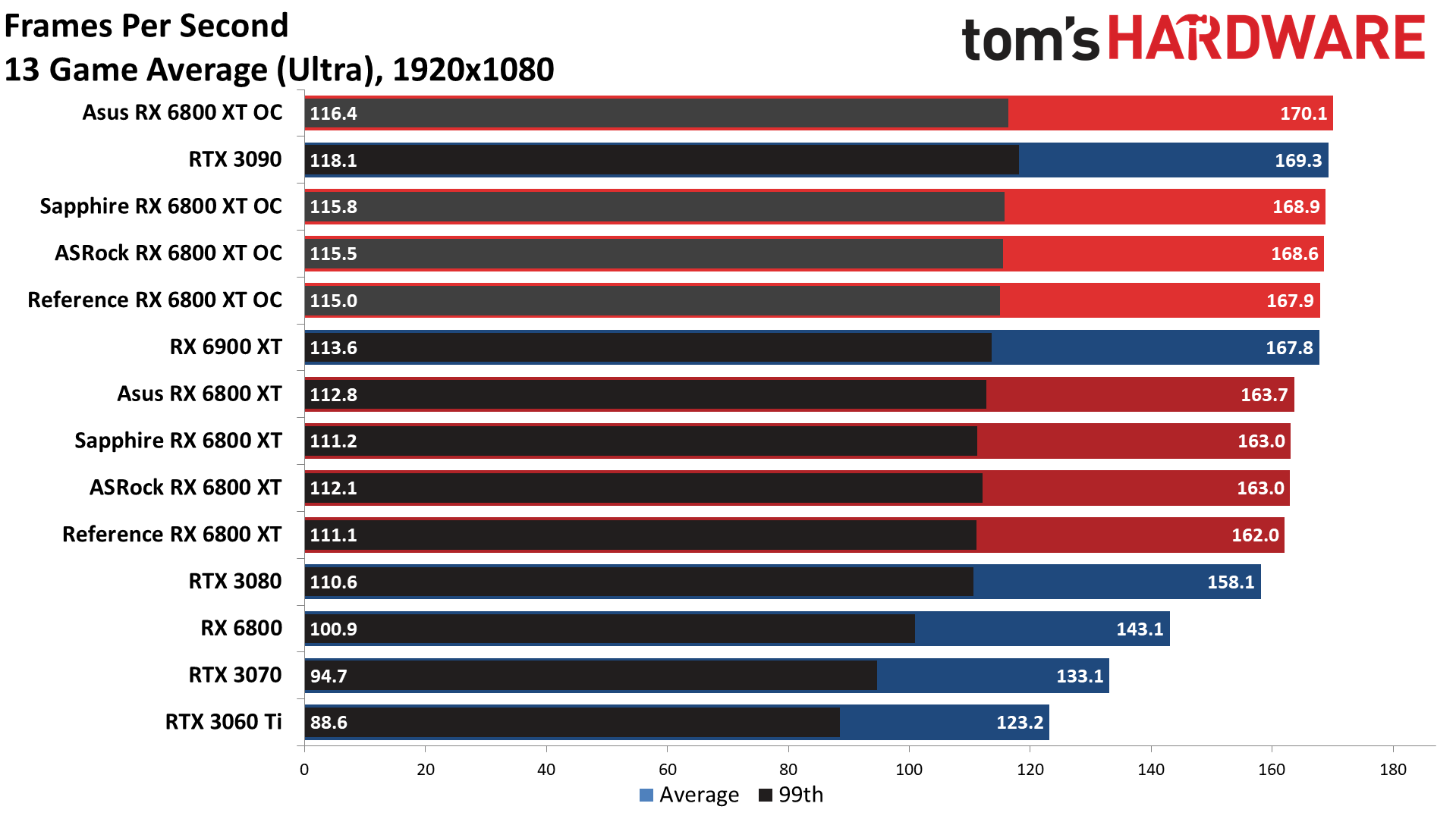
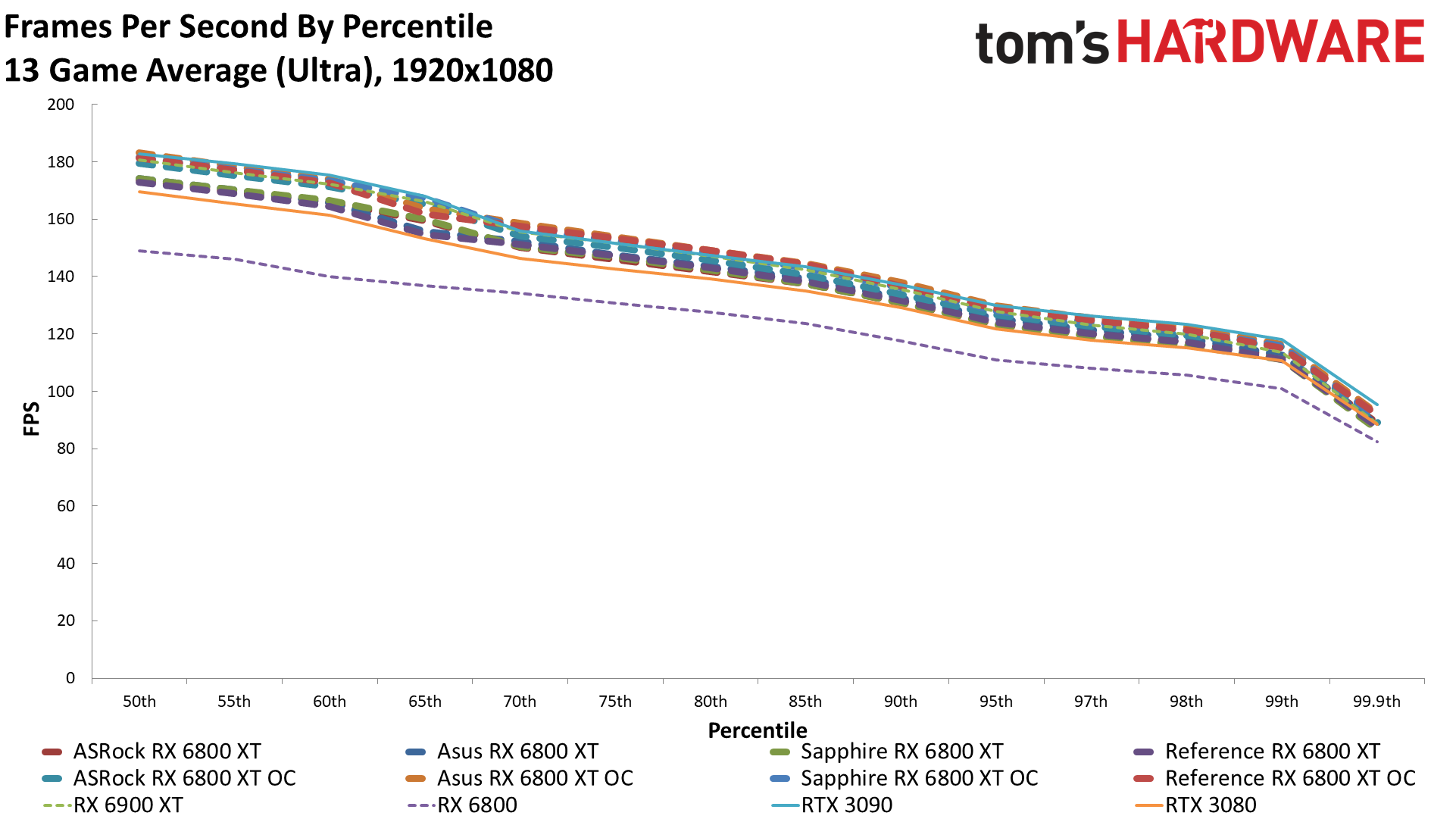
Given the mix of games and APIs used, it's not too surprising that the top four GPUs (RTX 3090, RX 6900 XT, RX 6800 XT, and RX 3080) end up relatively close in performance. The overclocked 6800 XT cards end up tying the 3090 and 6900 XT, but we're also hitting CPU bottlenecks in many of the games. While you can make the argument that 1080p is still the most popular resolution, and it's also the only place where you can get 240 Hz and 360 Hz displays right now, the latter is really only beneficial for a few select esports games. Out of the 13 games we tested, only Strange Brigade (which isn't exactly a popular game) breaks 240 fps at 1080p, and five of the games don't even get above 144 fps at the settings we've used.
As far as the four 6800 XT cards go, the results are pretty close to margin of error differences. The Asus Strix LC does take first place at both stock and overclocked settings, and the AMD reference card does take fourth place, but in general, you wouldn't be able to tell the cards apart when actually playing games.
Get Tom's Hardware's best news and in-depth reviews, straight to your inbox.
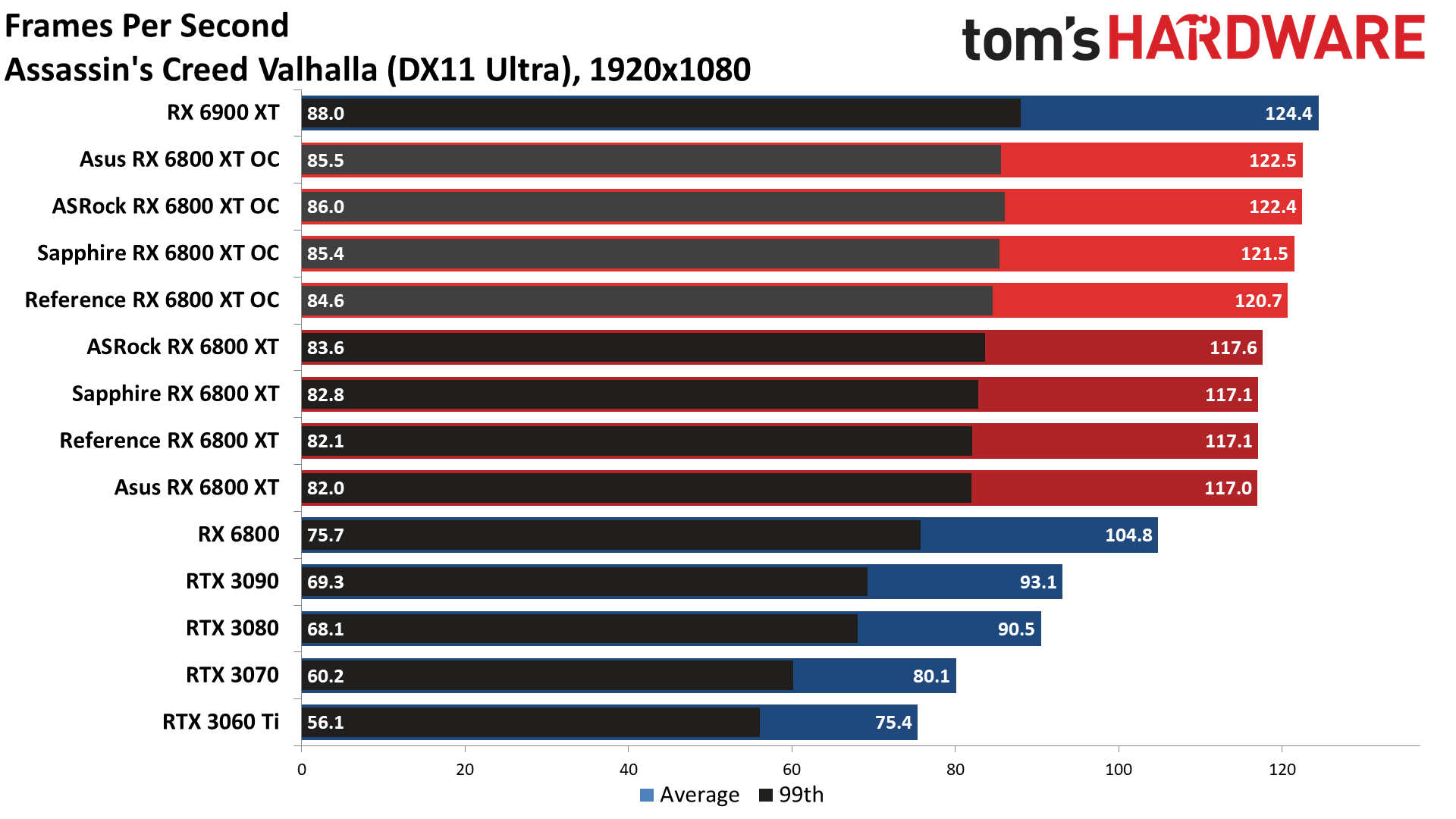
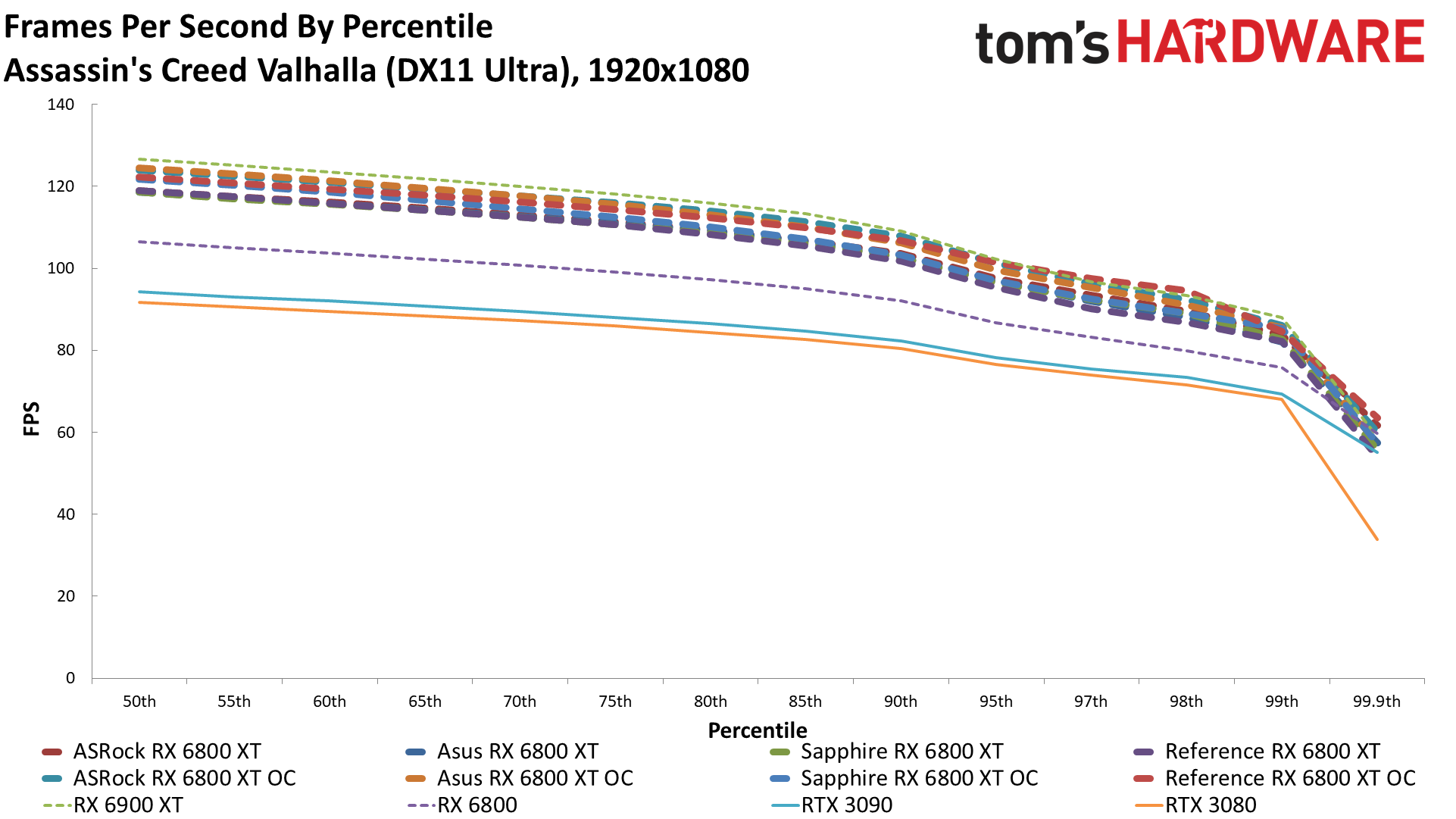


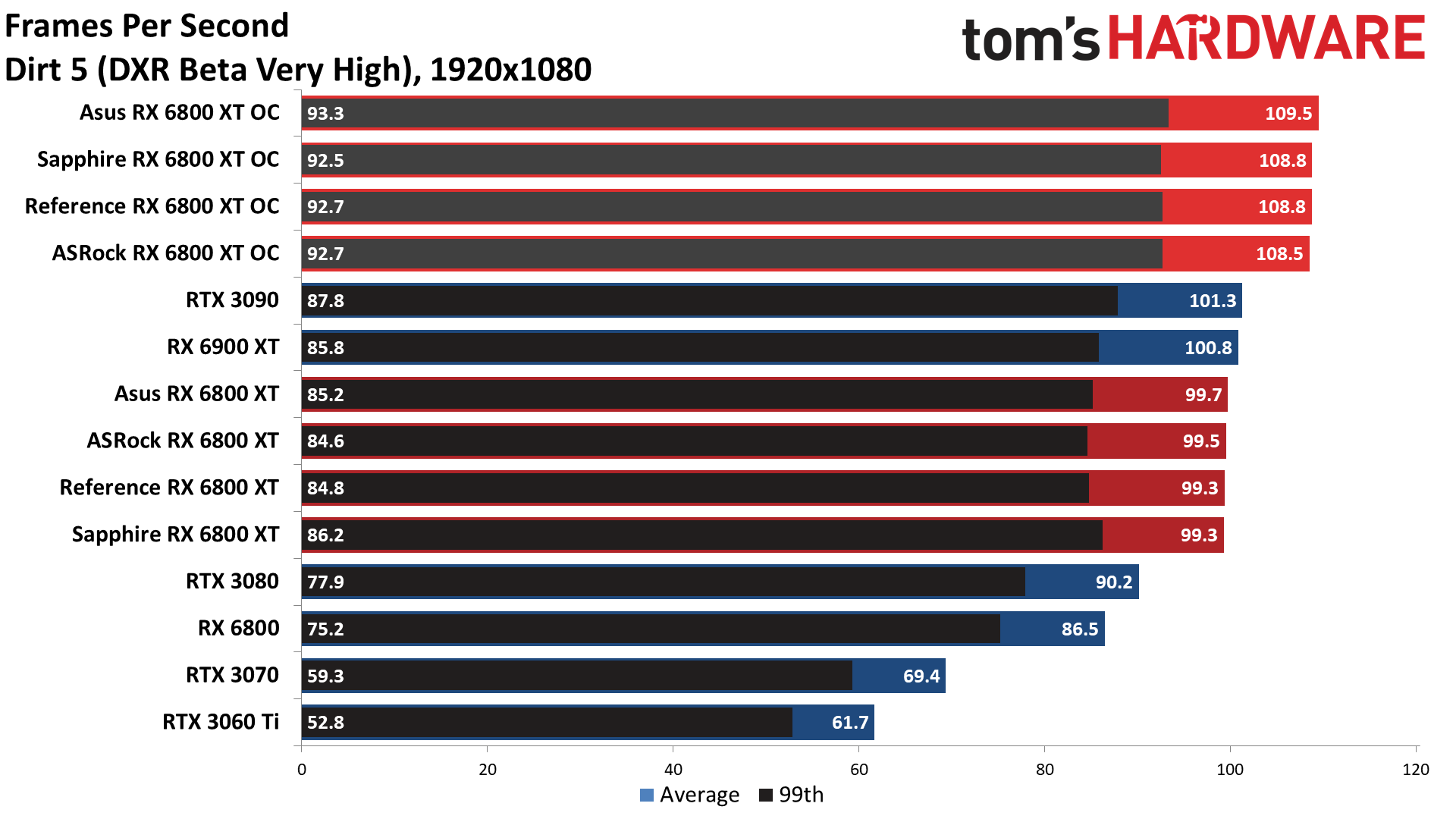
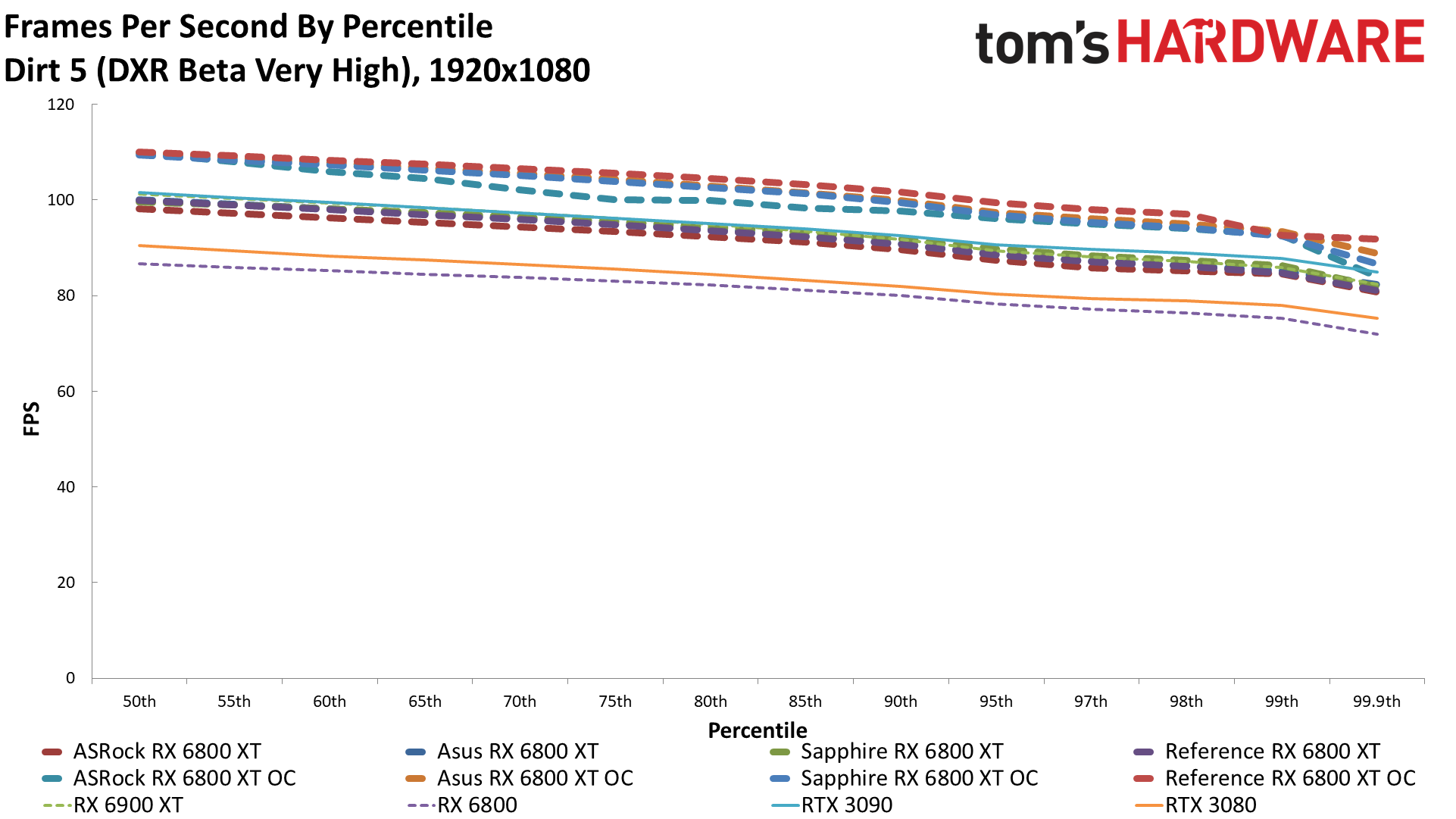
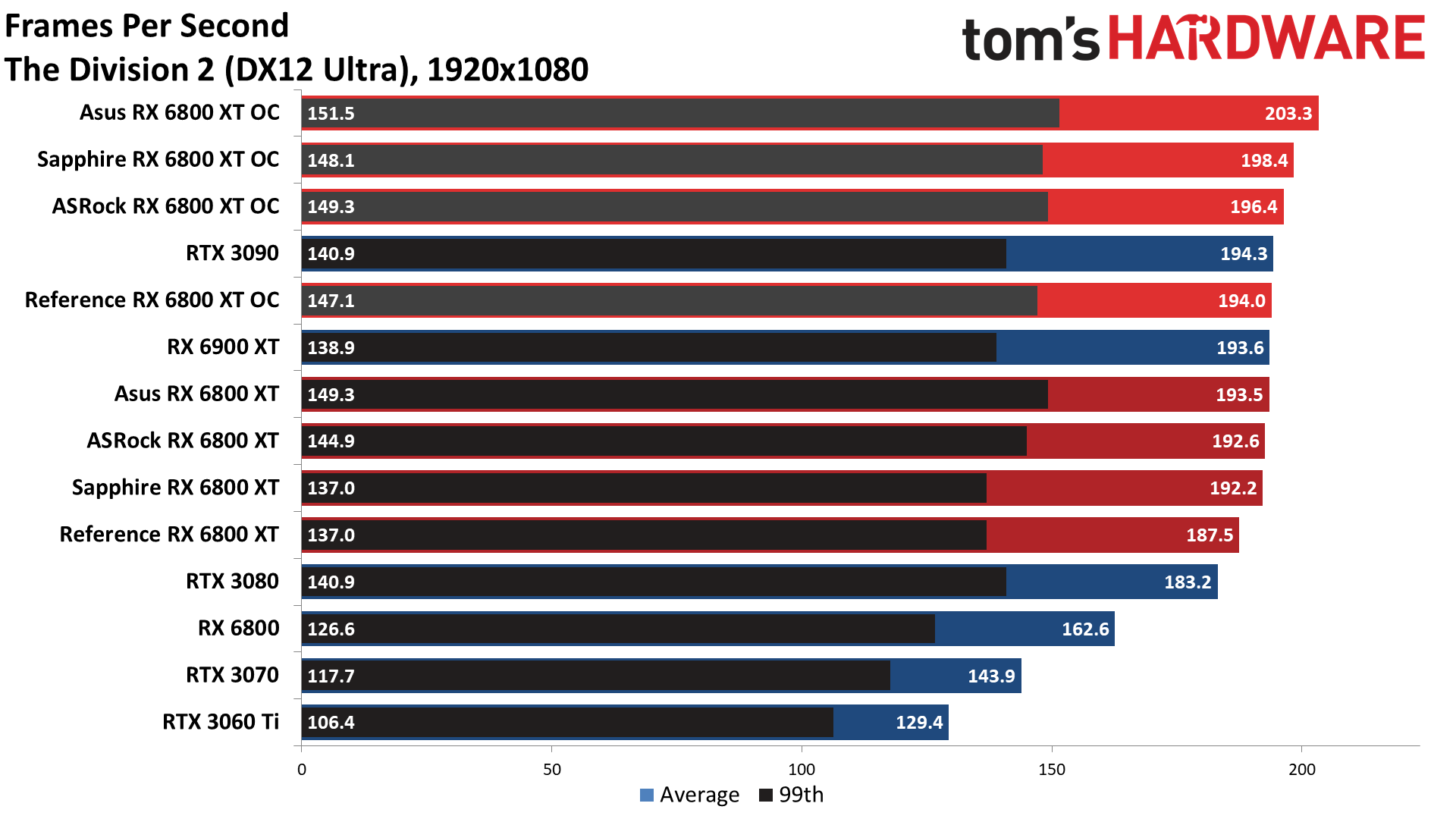
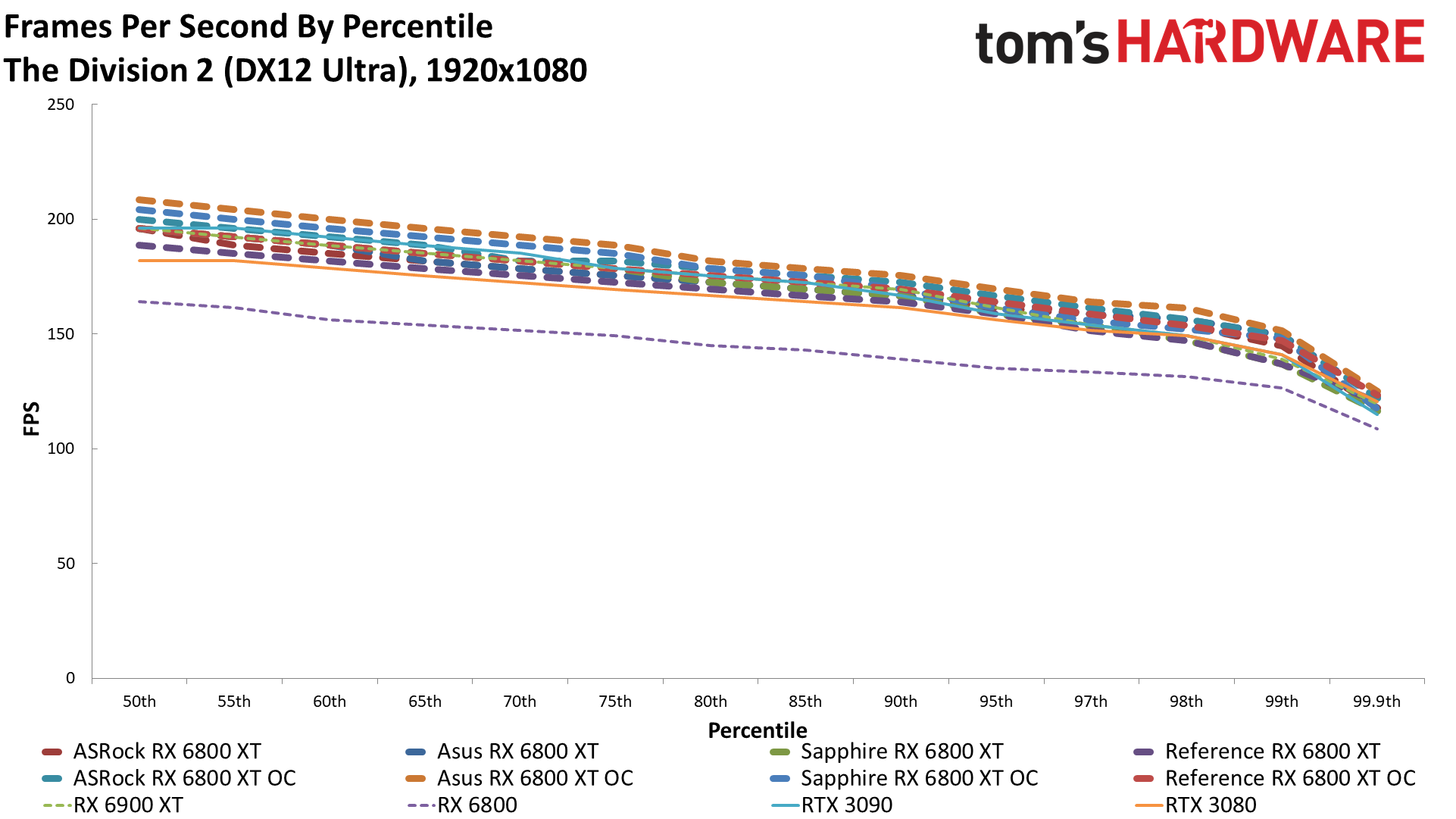
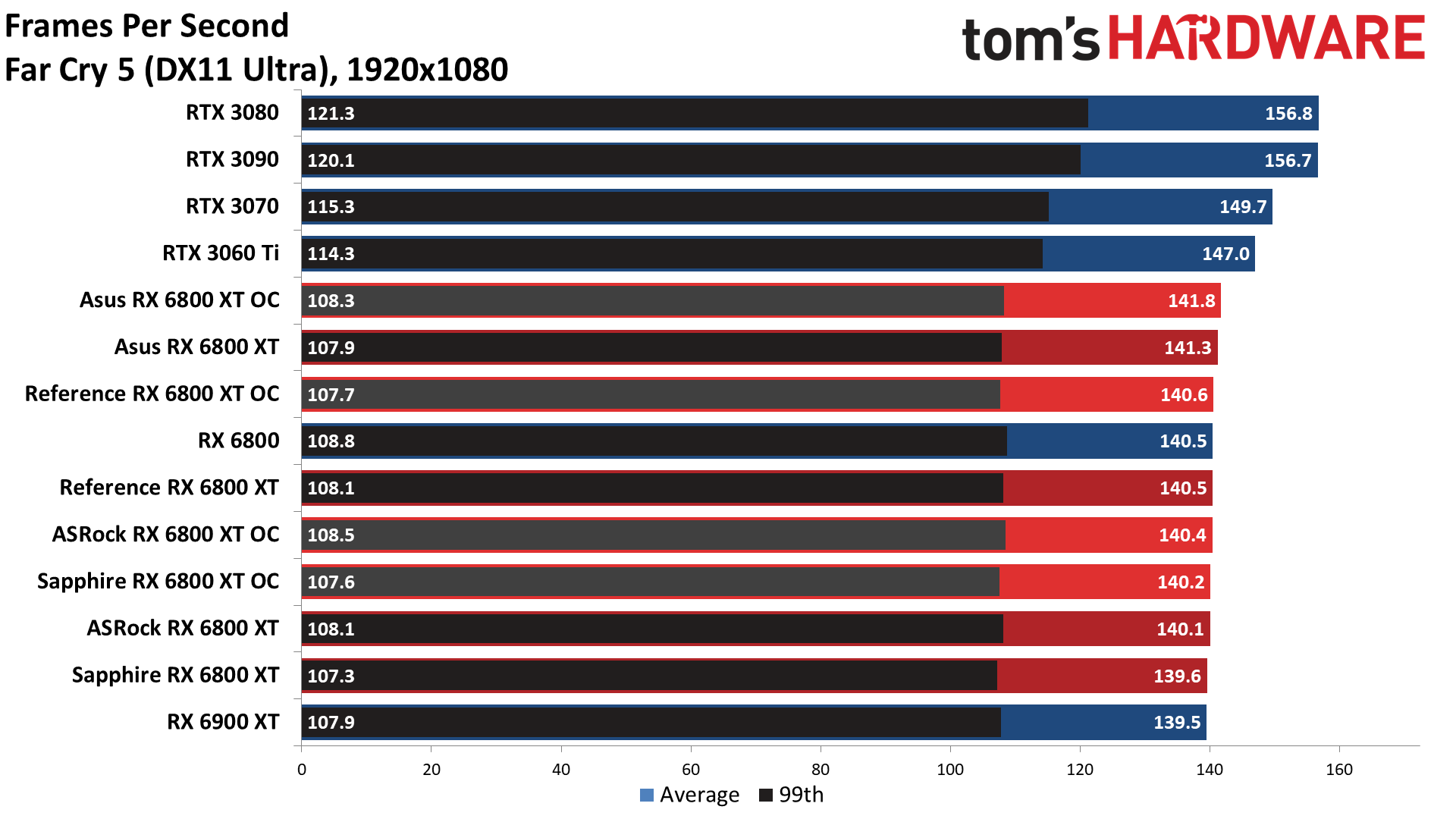
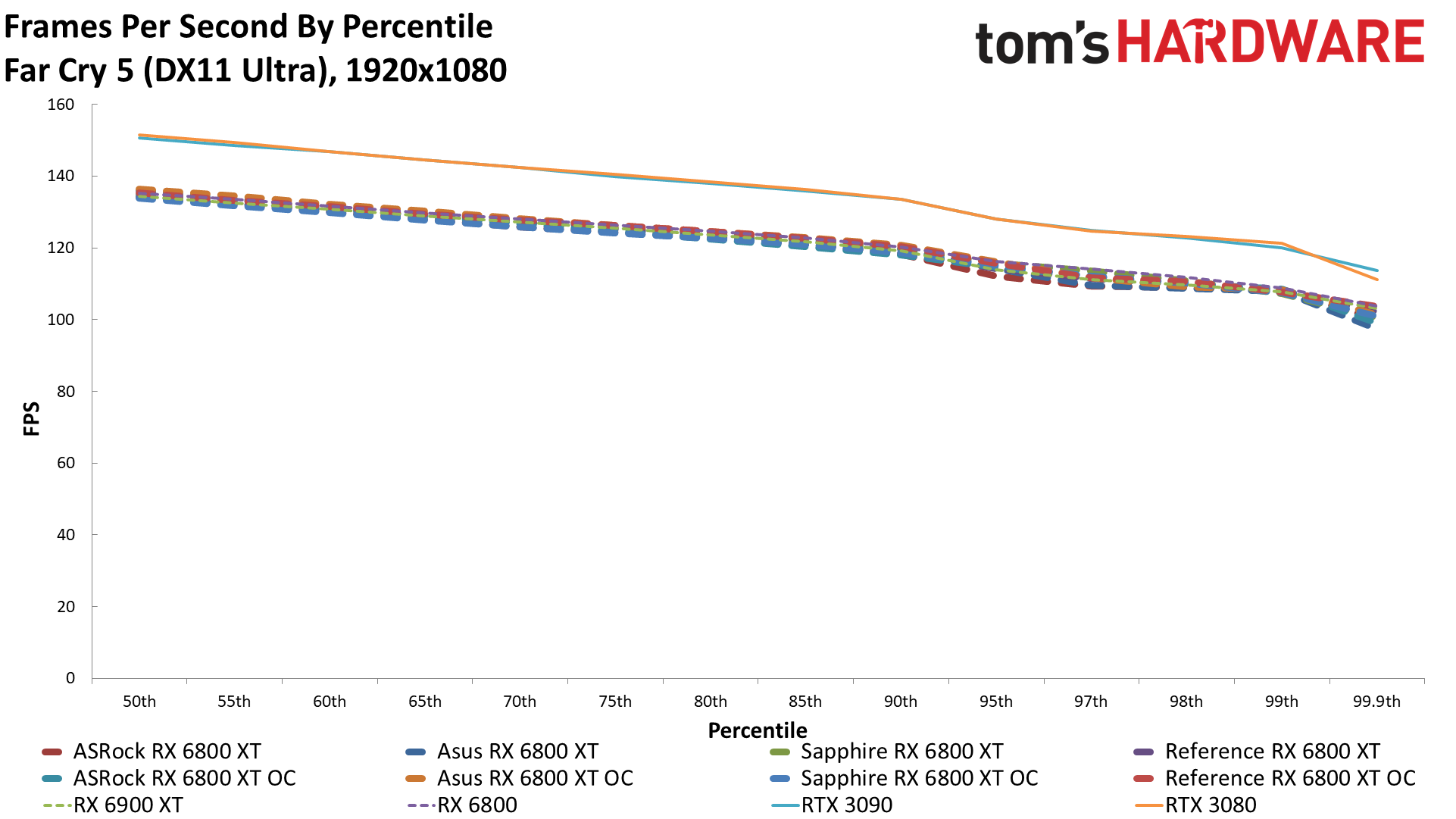
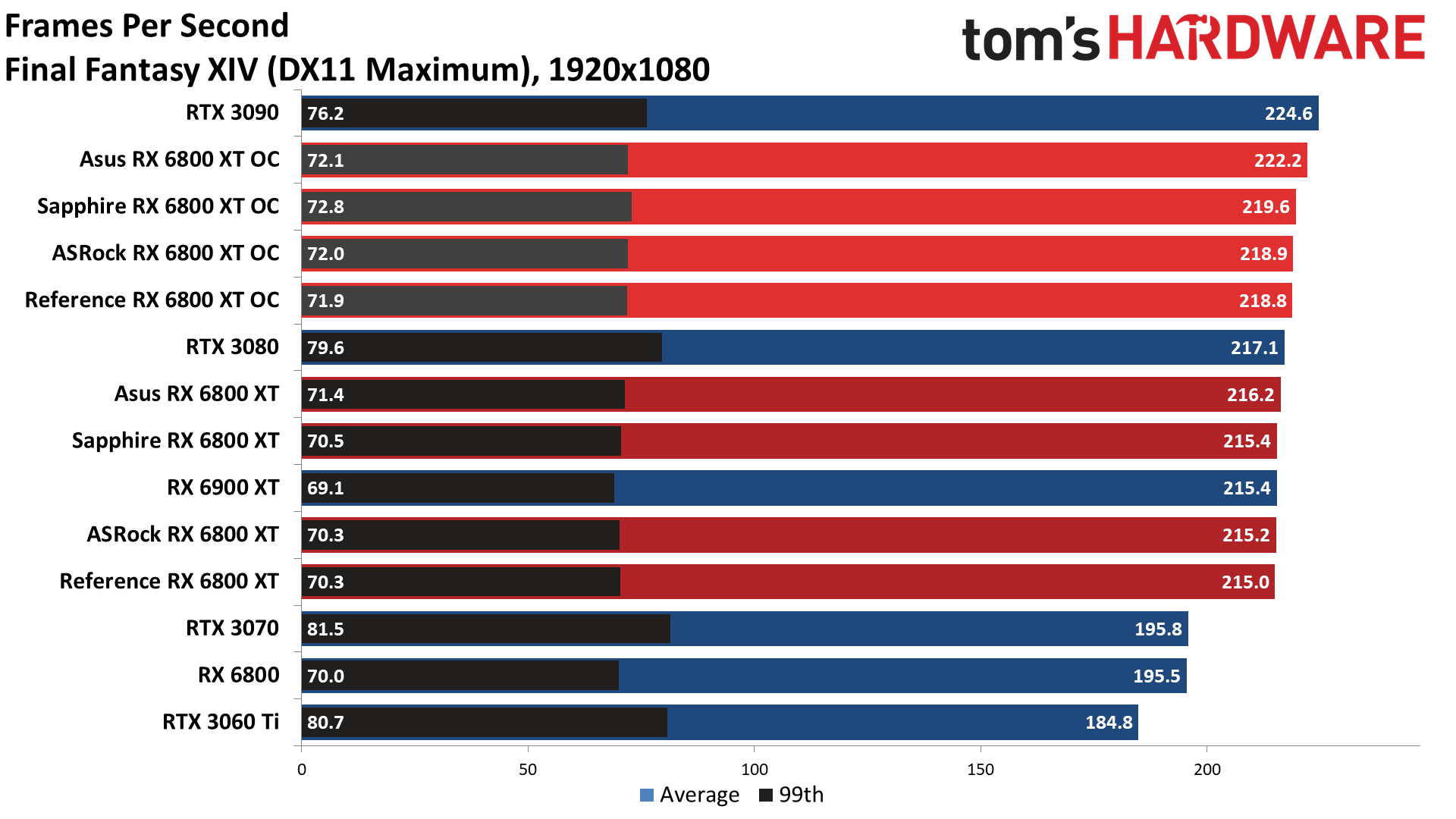
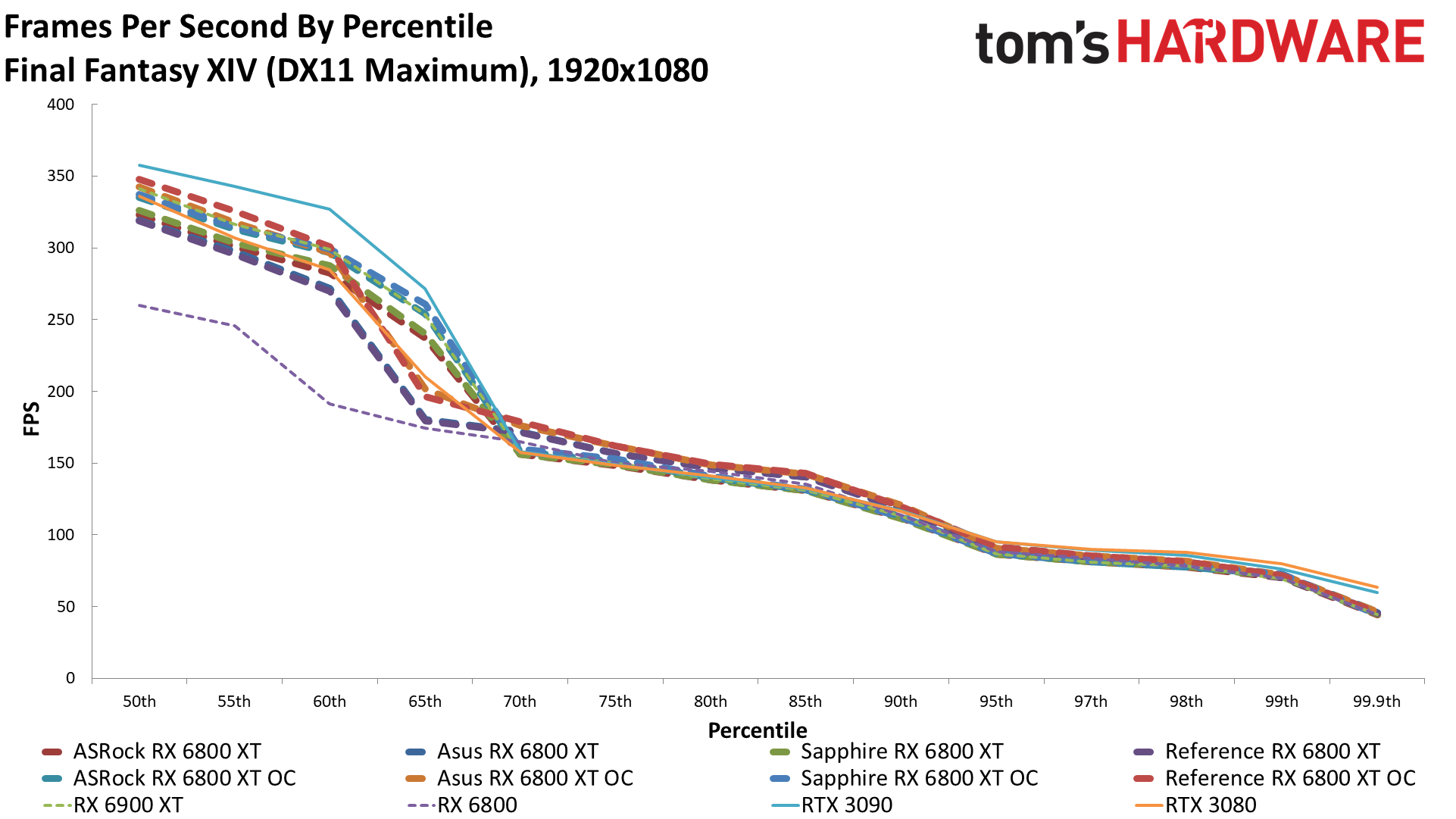
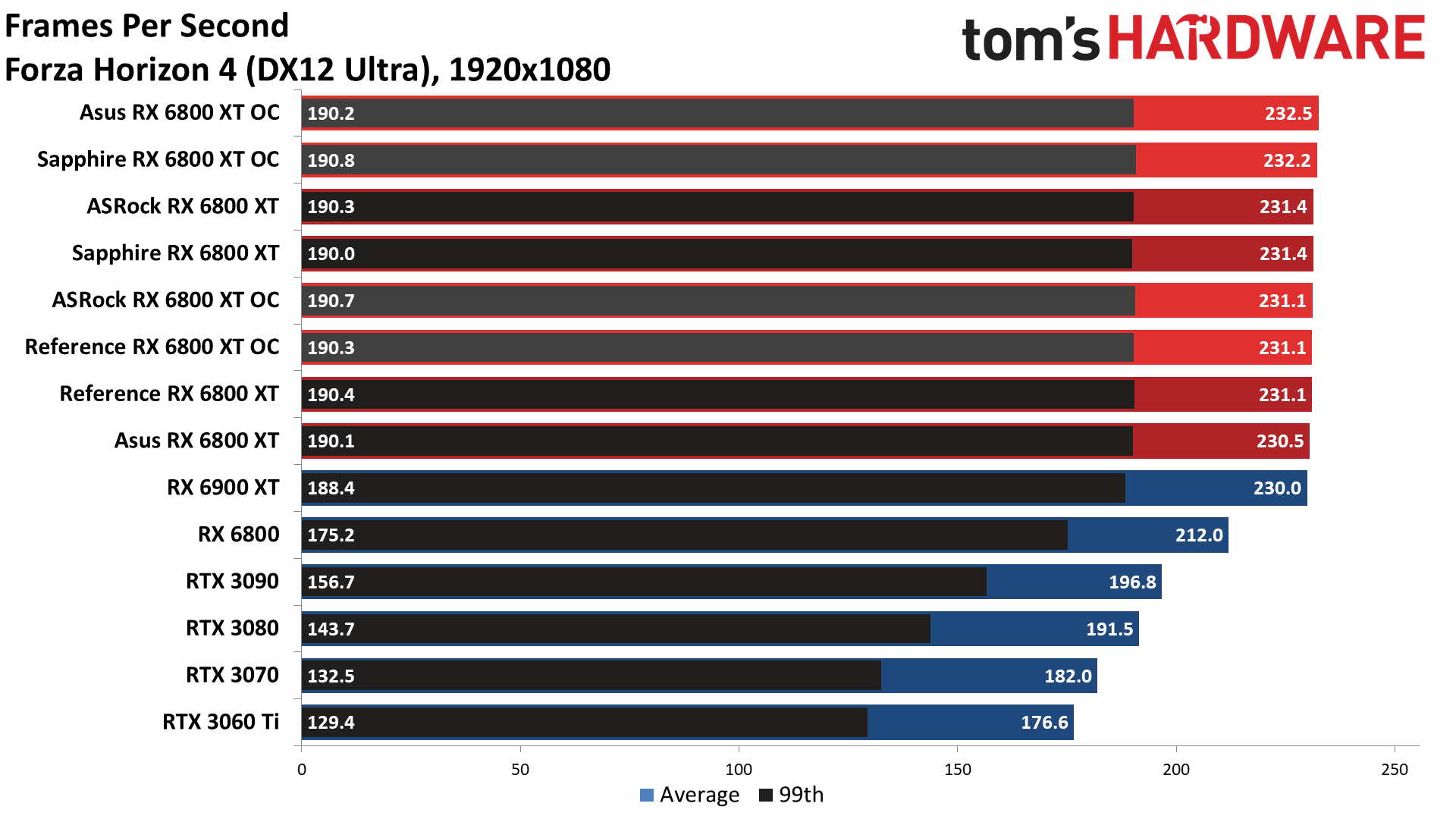
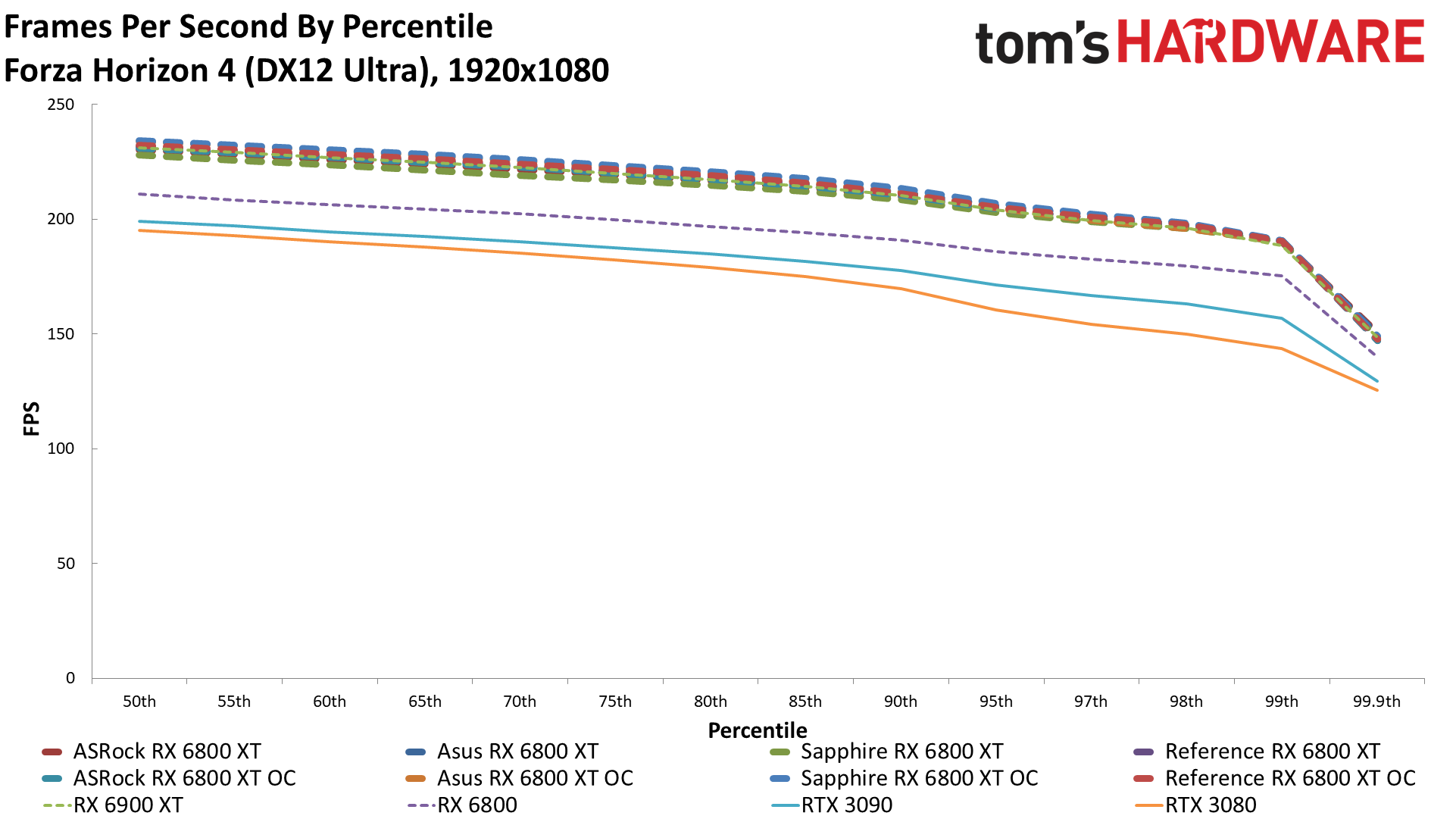


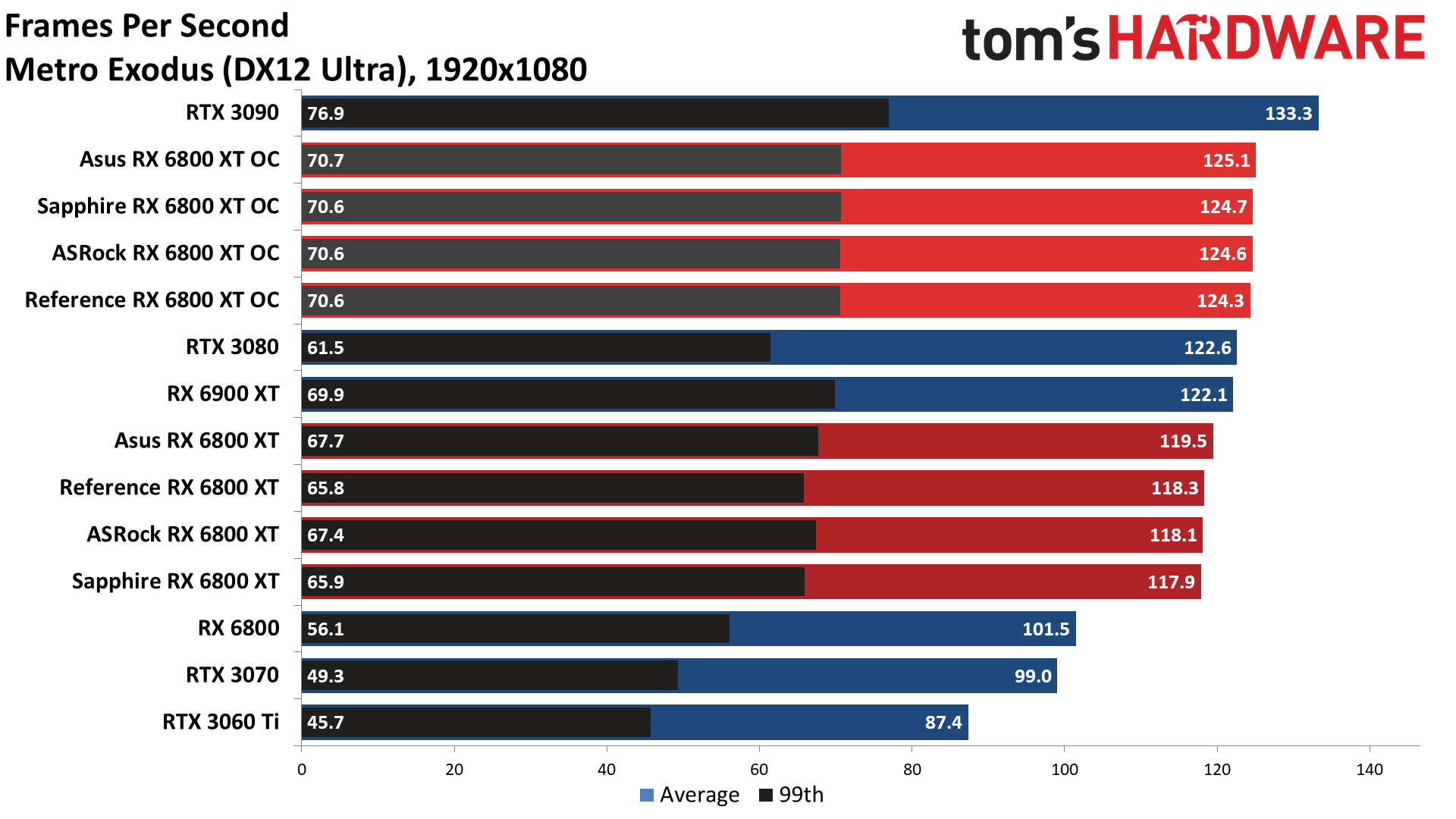
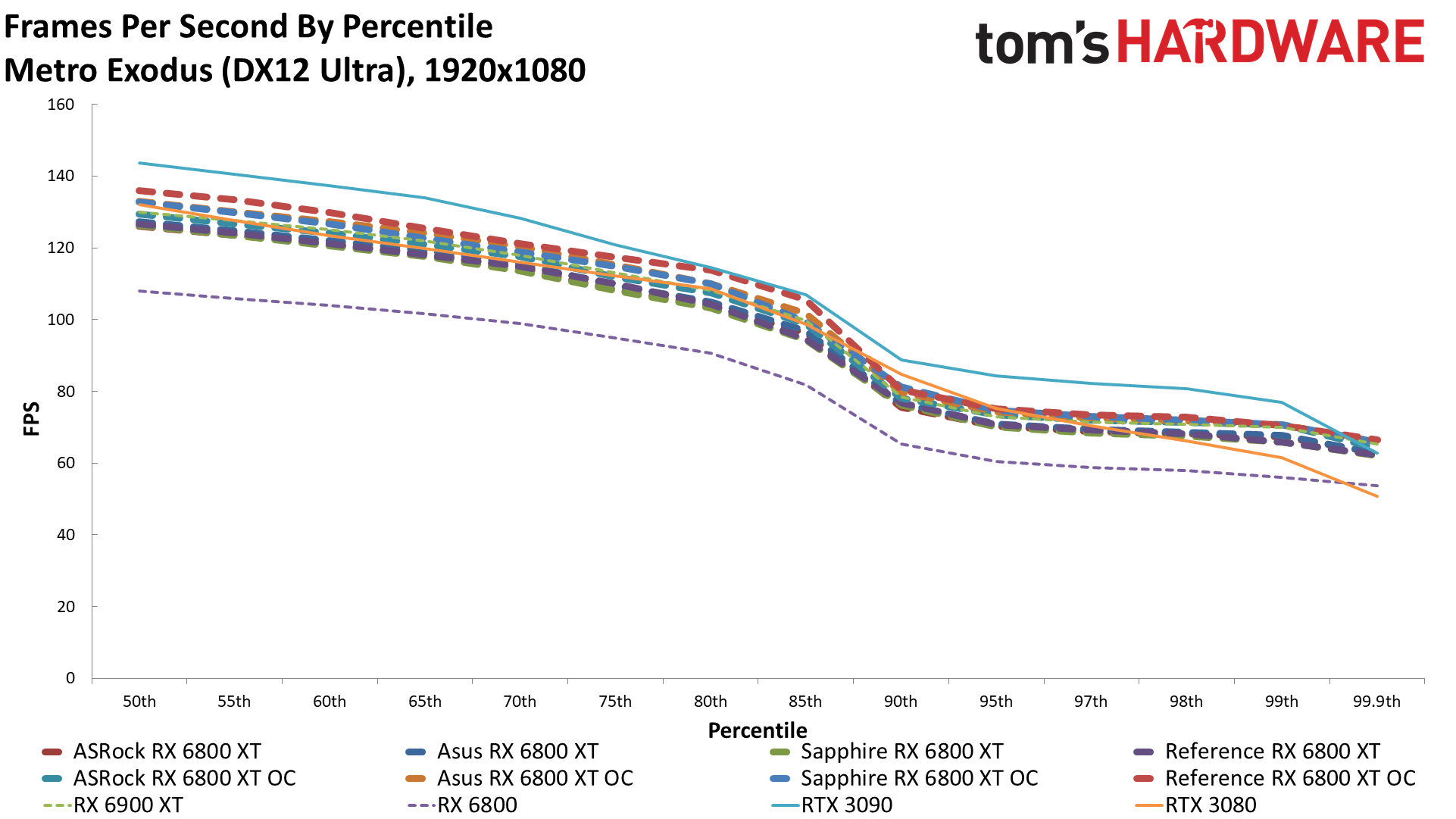

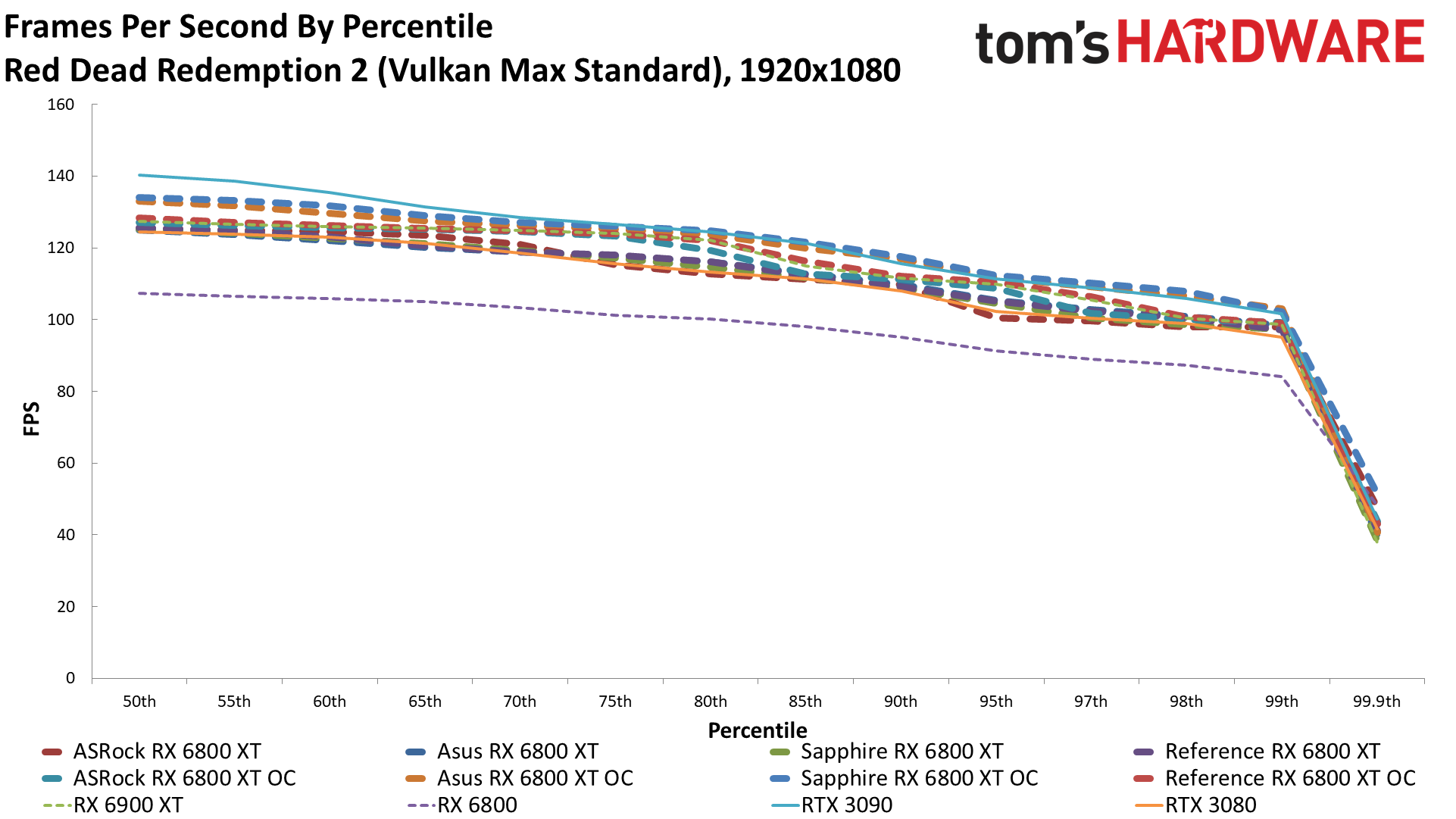
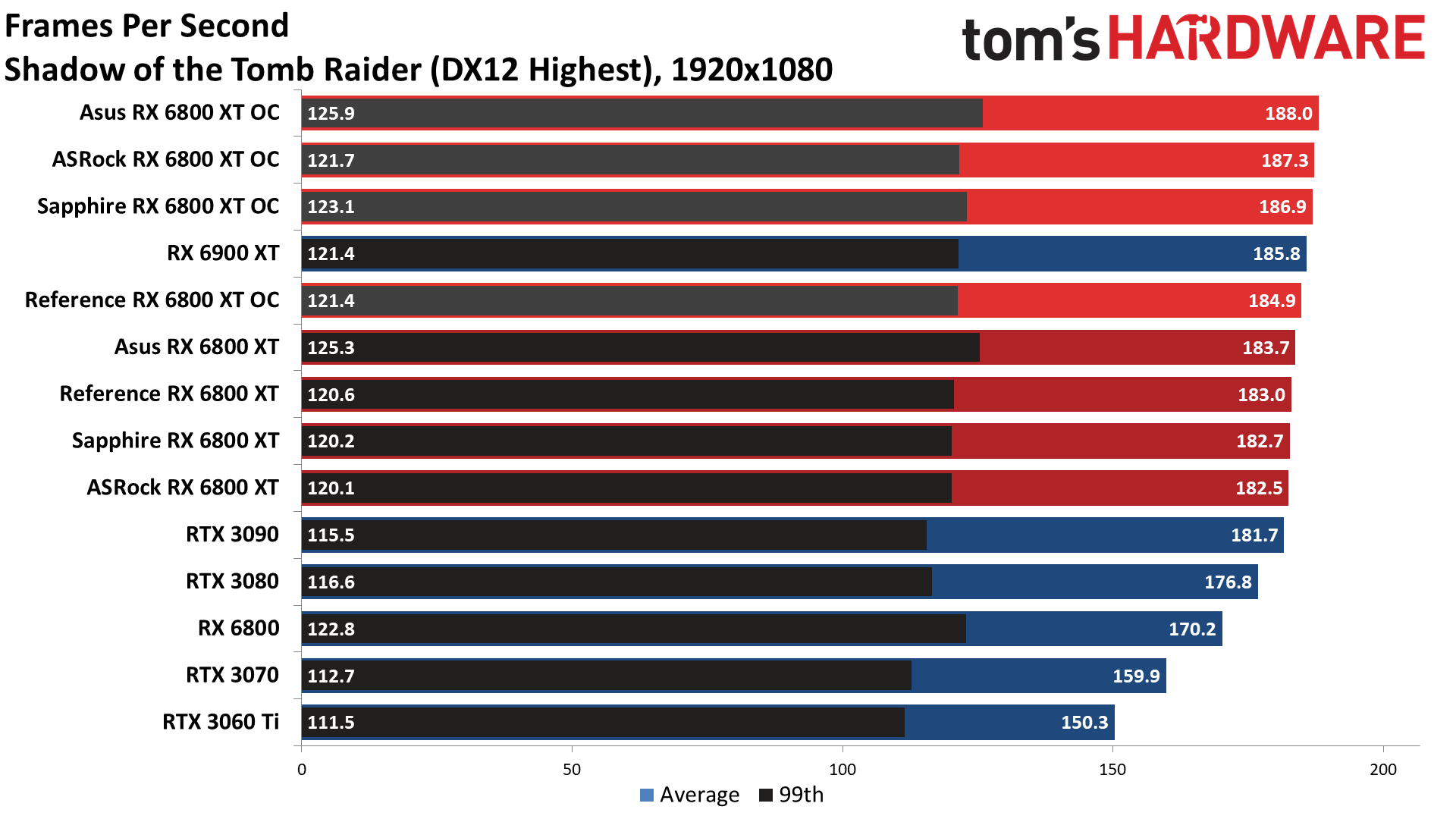
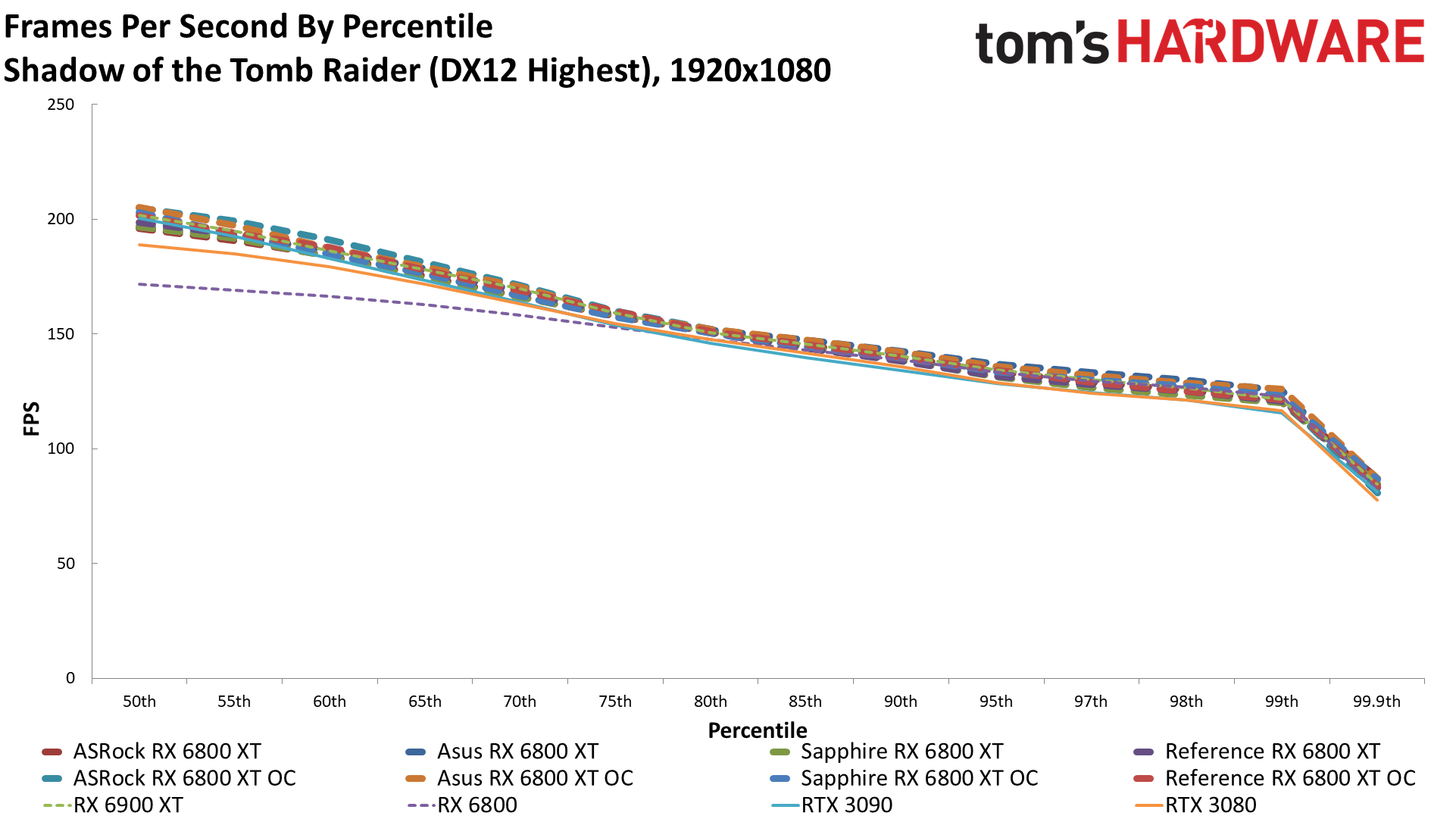
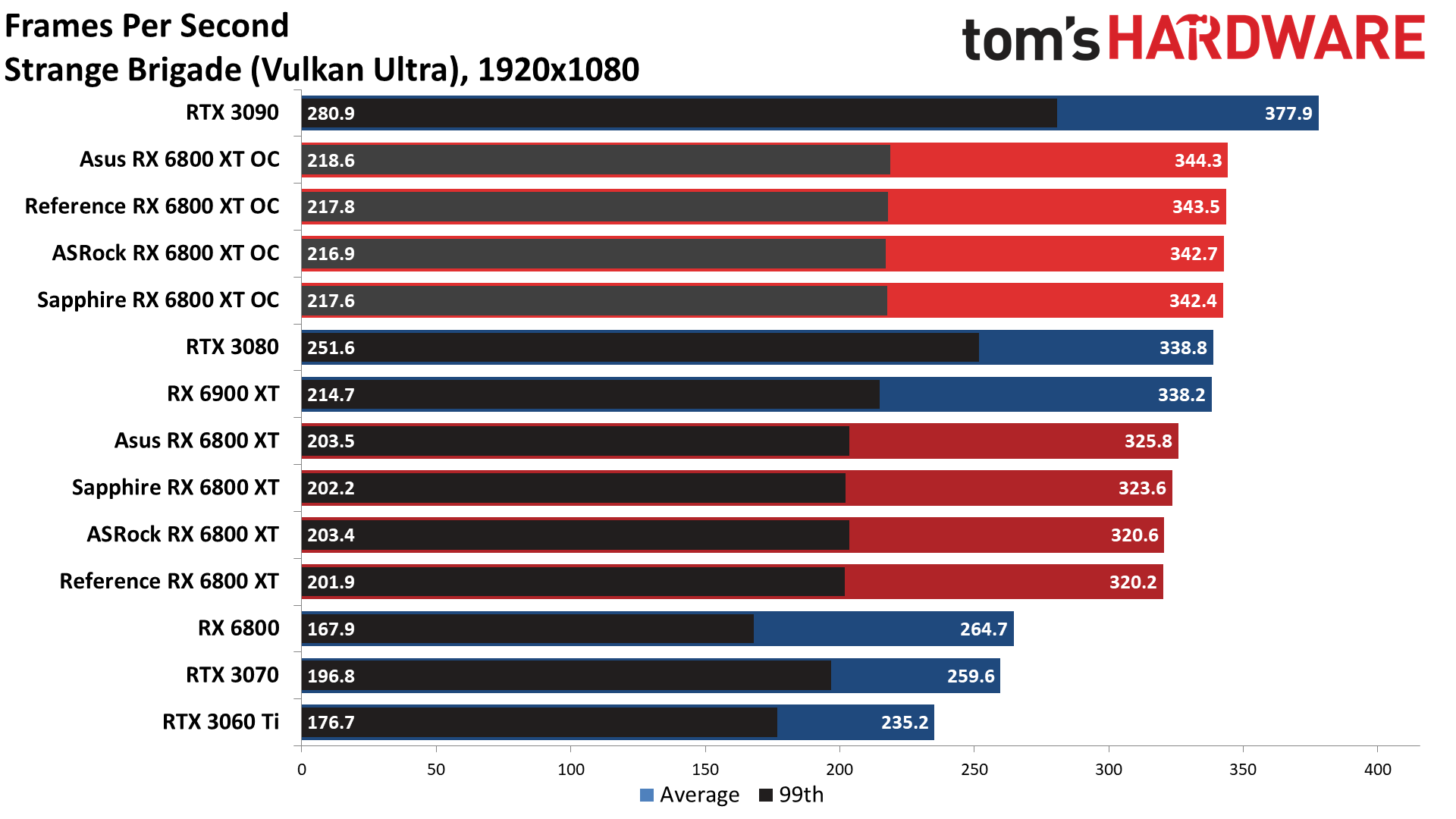
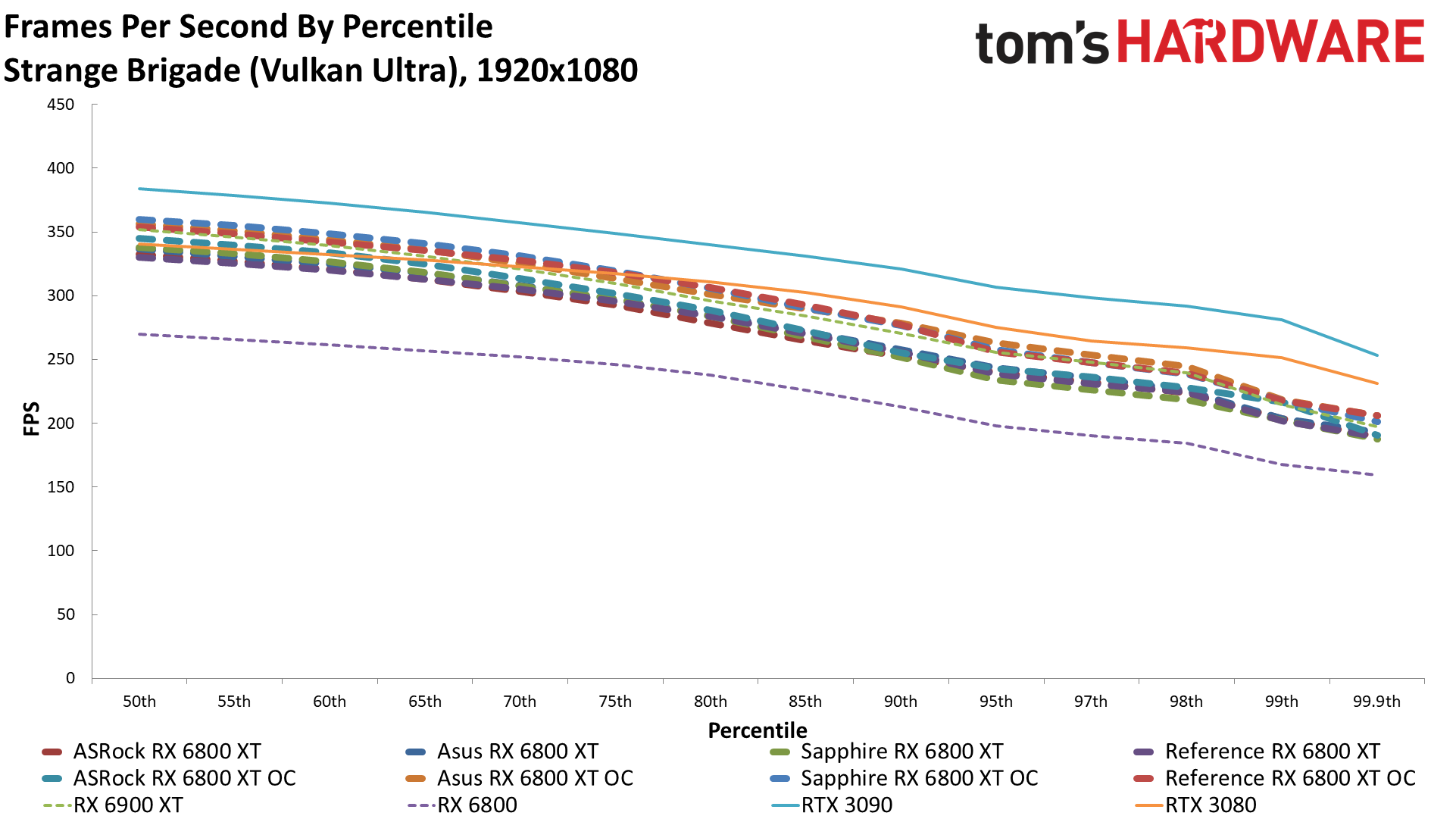
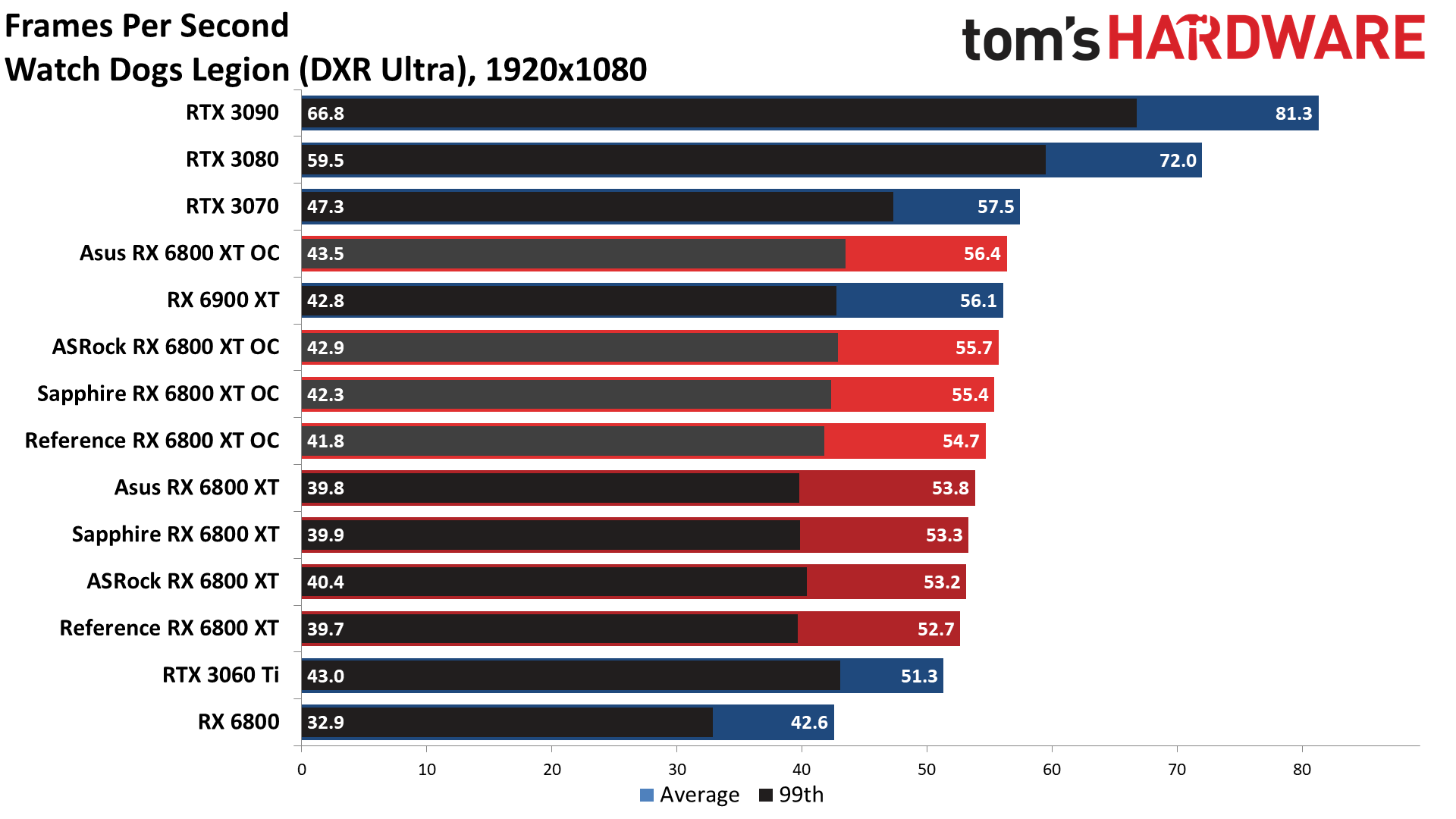
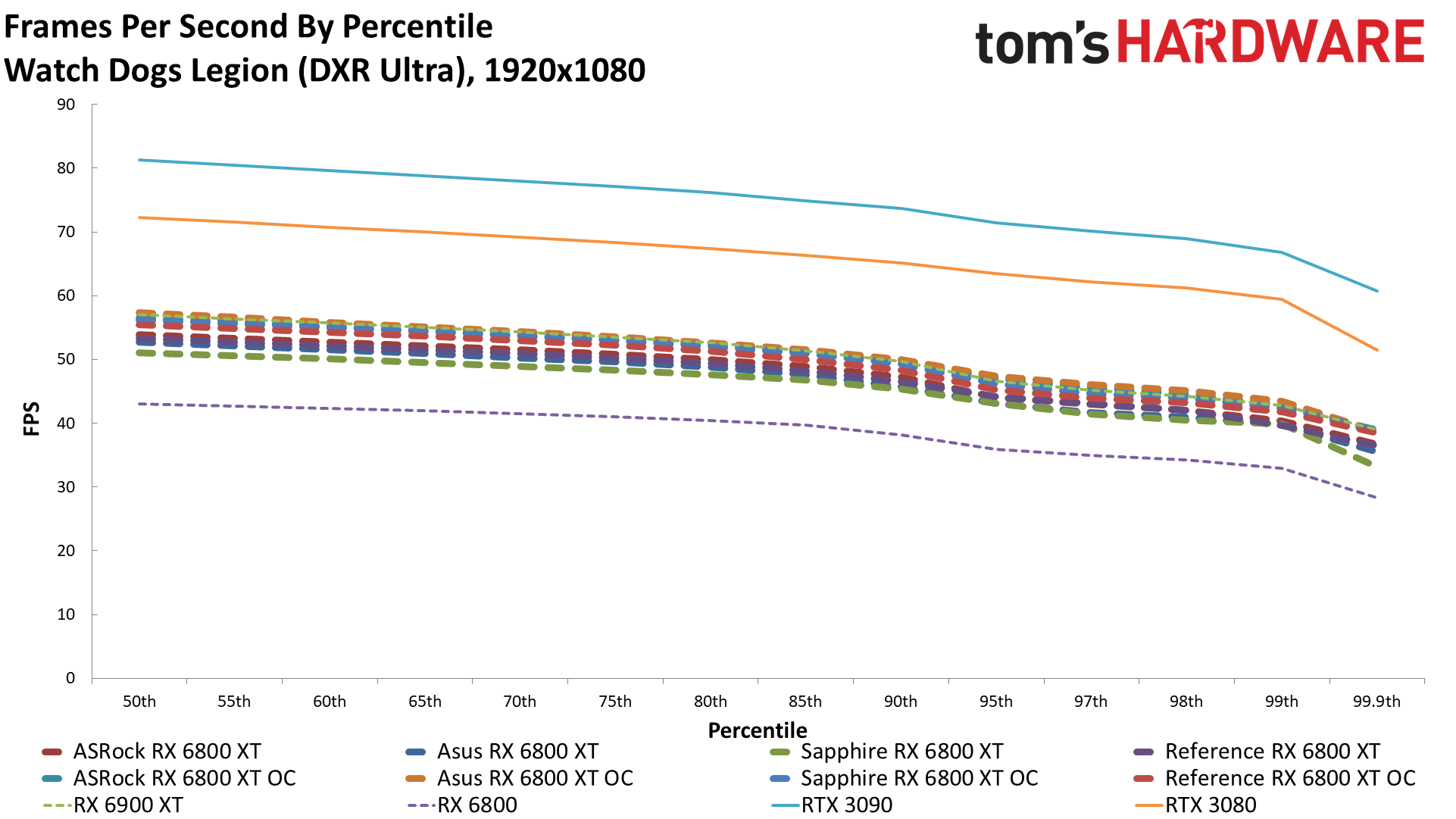
Looking at the individual games, there's a bit of variability in some instances, like The Division 2, but nothing that gives us any real indication that any of the custom cards are clearly superior. Aesthetics, availability, features, and pricing are going to be much greater factors than pure performance.
MORE: Best Graphics Cards
MORE: Desktop GPU Performance Hierarchy Table
MORE: All Graphics Content
Current page: Radeon RX 6800 XT Roundup: 1080p Gaming Benchmarks
Prev Page Sapphire Nitro+ RX 6800 XT Review Next Page Radeon RX 6800 XT Roundup: 1440p Gaming Benchmarks
Jarred Walton is a senior editor at Tom's Hardware focusing on everything GPU. He has been working as a tech journalist since 2004, writing for AnandTech, Maximum PC, and PC Gamer. From the first S3 Virge '3D decelerators' to today's GPUs, Jarred keeps up with all the latest graphics trends and is the one to ask about game performance.
-
Makaveli Canadian pricing for these cards. Asrock from newegg.ca and the last two from canada computers.Reply
ASRock Radeon RX 6800 XT Taichi Gaming $1499
SAPPHIRE NITRO+ Radeon RX 6800 XT $1149
ASUS ROG STRIX LC Radeon RX 6800 XT $1299
And for the money Asus is asking for this card, they could have alteast sleeved those fan cables its mess. For $1000+ asking price kinda of a slap in the face. -
Jobeker Your testing methodology is flawed.Reply
The memory should not be overclocked in these cards.
These cards show much better results once you push the GPU to the max & leave the memory at stock.
It seems that you & all the other testers I have come to respect in almost 2 decades of reading tests & benchmarks , have become fixated on maxing the mem to the point of "no crush" without even comparing the results.
I hope you still have at least one of the cards at hand to make 1 more test, you will see that stock mem@2000mhz + GPU@2600mhz gets much better results than mem@2140mhz + GPU@2600mhz .
I am active on a different language forum & a local system builder/fine tuner corroborated these results with several different 6800XT cards.
( he is the one that Identified this issue , I don't own such a card at the moment)
He is now testing a 6900XT .
As a bonus , once you leave the memory at stock you get a few extra watts for higher gpu oc.
I don't care that much about the actual value of the specific cards ( definitely not at current pricing ) it is however very important for me to make sure you testing methodology isn't flawed.
I seriously hope you still have one of the cards for one more test . -
JarredWaltonGPU Reply
Define "much better results" for me, please. The overclocking is not supposed to be the major focus, because silicon lottery and other elements come into play. Frankly, I wouldn't bother overclocking most GPUs -- it's just not enough of a gain to warrant the added power and potential stress on the hardware. Anyway, a 7.5% memory OC isn't much, and neither is the 3-7% increase in performance I measured with the 'max' OC I achieved.Jobeker said:Your testing methodology is flawed.
The memory should not be overclocked in these cards.
These cards show much better results once you push the GPU to the max & leave the memory at stock.
It seems that you & all the other testers I have come to respect in almost 2 decades of reading tests & benchmarks , have become fixated on maxing the mem to the point of "no crush" without even comparing the results.
I hope you still have at least one of the cards at hand to make 1 more test, you will see that stock mem@2000mhz + GPU@2600mhz gets much better results than mem@2140mhz + GPU@2600mhz .
I am active on a different language forum & a local system builder/fine tuner corroborated these results with several different 6800XT cards.
( he is the one that Identified this issue , I don't own such a card at the moment)
He is now testing a 6900XT .
As a bonus , once you leave the memory at stock you get a few extra watts for higher gpu oc.
I don't care that much about the actual value of the specific cards ( definitely not at current pricing ) it is however very important for me to make sure you testing methodology isn't flawed.
I seriously hope you still have one of the cards for one more test .
Dropping the memory OC and trying for a slightly higher core OC is totally within the parameters of what can be done, and may improve performance more than what I've shown. More effort on tuning voltages, fan speeds, etc. could also improve performance. Without physically modding the cards, though, I strongly doubt you'll see more than a 5% improvement over what I achieved, which is a 10% potential total improvement. In practice, I'm sure it would be far less than that -- probably only a 1-2% difference from my max core + max RAM OC results. And there's a very good chance that, despite what you're positing, overclocking the memory actually does improve performance.
Let me give you just one example, because based on this I see no reason to bother retesting anything more.
SettingAsus Strix LC RX 6800 XT OCAsus Strix LC RX 6800 XT OC StockRAMAsus Strix LC RX 6800 XTMetro Exodus1080p Ultra125.09123.2119.46
1440p Ultra105.43103.6999.77
4k Ultra69.4468.5264.81
So, in at least one game, using the same card in all three cases (the Asus Strix LC), dropping the RAM OC but leaving the GPU at the same 2600 MHz setting reduced performance by 1-2%. So much for my "flawed" methodology. -
shady_021 The only thing I see here is all 6800 XT are equal or slightly ahead of a 6900 XT... so except for the price difference what's the point of having a 6900XT?Reply -
JarredWaltonGPU Reply
The overclocked RX 6800 XT cards match the stock RX 6900 XT. If I overclocked the 6900 XT as well, it comes out a bit ahead again.shady_021 said:The only thing I see here is all 6800 XT are equal or slightly ahead of a 6900 XT... so except for the price difference what's the point of having a 6900XT?
This is something I pointed out in the RX 6900 XT review: it has identical clocks, TDP, and VRAM, so the only difference is 80 CUs instead of 72 CUs. That means at most an 11% advantage for the 6900 XT, but because of VRAM being the same it is usually more like 4-5%. So it's not really worth the extra $350, except none of the 6800 XT cards cost $649, and none of the 6900 XT cards cost $999 -- and in fact, neither of those really exists in any meaningful quantity AFAICT. Tens of thousands of cards worldwide perhaps, but that's a drop in the proverbial bucket. -
Jobeker JarredWaltonGPU , Thank you for taking interest in my comment & performing the relevant tests.Reply
I've ( we actually ) been fed with a lot of information in the past 2 weeks that led me to believe the claim I made .
I apologize that it came out rude.
I trust your findings better .
Thank you. -
HC1Gunner Reply
Question, how is this a round up, when other manufactures like Gigabyte weren't included?Admin said:We've rounded up multiple Radeon RX 6800 XT cards to see how the various models stack up. Higher factory overclocks, liquid cooling hybrids, massive coolers, and increased pricing are the general trend while GPUs continue to be in short supply.
AMD Radeon RX 6800 XT Roundup: ASRock, Asus, and Sapphire Reviewed : Read more
Kind of stupid to do these reviews, when you can't find any of these cards for retail sale. -
pbergonzi Reply
Thank you for your thoughtful testing and article.Admin said:We've rounded up multiple Radeon RX 6800 XT cards to see how the various models stack up. Higher factory overclocks, liquid cooling hybrids, massive coolers, and increased pricing are the general trend while GPUs continue to be in short supply.
AMD Radeon RX 6800 XT Roundup: ASRock, Asus, and Sapphire Reviewed : Read more -
JarredWaltonGPU Reply
A roundup isn't every card or manufacturer possible; it's a roundup of the cards we were sent. So rather than three individual 6800 XT reviews, you get a roundup of three cards plus the reference model.HC1Gunner said:Question, how is this a round up, when other manufactures like Gigabyte weren't included?
Kind of stupid to do these reviews, when you can't find any of these cards for retail sale.